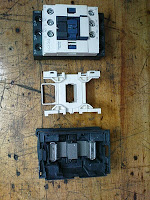 |
| relay |
 |
| relays coil |
At the end of the movable iron part have adapted one or usually more electrical contacts, insulated from one another as well as to the electromagnet.
As the voltage across the coil exists, there is magnetism. When you stop the voltage, a spring that has meanwhile compressed is geting back the electrical contacts.
 |
| parts of one relay |
 |
| relays label |
There is great variety in the number of contacts, size and operating voltages of the coil.
There relay specially constructed to withstand more effectively in resistive (eg, resistance heating), inductive (eg motors) or capacitive load (eg compensation capacitors)
A form of relay common in industry and in control of three phase electric motors is that of photographs.
 |
| relays contact |
 |
| Smal finder relays |
Problem dysfunction can occur after heavy use or poor choice of power or damage to load - consumption control. Usually the power contacts are those most frequently damaged.
The ends of the coil Names as A1 and A2 in the majority of manufacturers relay.
 |
| relays contact |
 |
| Electronic board with relays |
The contacts withstand current for motors 5,5 KWatts called power contacts and is three Normally Open, one for each phase.
The remaining contacts in the auxiliary relay are designed for low current and are from one to six. They also called contacts or auxiliary automation.
Usually an auxiliary NO is standard in main body of the relay, and if we want more NO or NC we must to buy separately and add them to the socket on the relay and are usually clipped
This comment has been removed by a blog administrator.
ReplyDelete